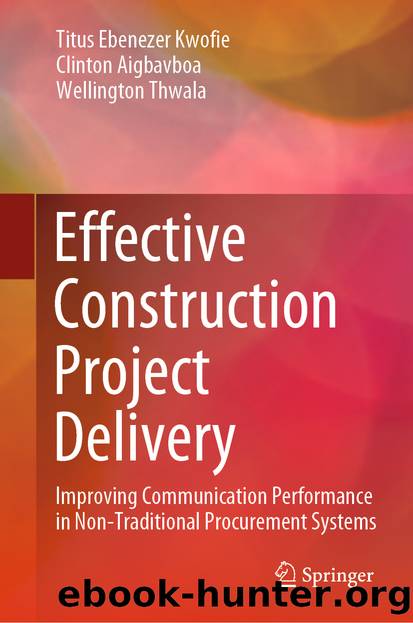Effective Construction Project Delivery by Titus Ebenezer Kwofie & Clinton Aigbavboa & Wellington Thwala

Author:Titus Ebenezer Kwofie & Clinton Aigbavboa & Wellington Thwala
Language: eng
Format: epub
ISBN: 9783030493745
Publisher: Springer International Publishing
Centrality
Measures the importance or prominence of an individual in a social network. Through the analysis of the strength of connections with other members of the communication network
Sources Tichy and Fombrun (1979), Guevara and Boyer (1981), Wasserman and Faust (1994), Garton et al. (1997), Thomas et al. (1998, 1999), Mead (1999), Xie et al. (2000), Liu (2009), Xie et al. (2010), Kwofie et al. (2015, 2016, 2017)
The survey was conducted for a period of four weeks through an online portal. Respondents who were identified on these projects were invited via email to respond on a Google form. The forms of non-traditional procurement listed were partnering, project alliancing, integrated project design and public–private partnership (PPP) arrangements. PPPs are generally deemed as a varied form of procurement arrangement distinct from the partnering arrangement (see Cui et al. 2018; Kwofie et al. 2016) hence the separation PPP from project alliance in the assessment. The respondents were invited to draw on their experience from the non-traditional procurement systems used on the projects in which they were involved and indicate the frequency of the communication performance indicators occurring in the communication with other parties in their communication and information sharing in the delivery of the project. The five-point Likert scale was interpreted as the following: 5 = very frequent, 4 = frequent, 3 = occasionally, 2 = rarely, 1 = never.
There was a total of 169 responses received forming a response rate of 59%. From the argument espoused by Takim et al. (2004), the 59% could be deemed as an acceptable response rate compared to the indicated 20–30% as the normal acceptable response rate for a questionnaire survey, especially in construction management research. Aggregation of the respondents revealed project managers (18%), architects (12%), contract/construction managers (10%), engineers (12%), quantity surveyors (29%), contractors (10%) and sub-contractors (6%) and suppliers (3%). A breakdown of the typology of non-traditional procurements involved in revealed that PA, IPD, partnering and PPP were the notable forms identified by respondents as used in the projects in which they were involved. Their experiences revealed that 32% had between 0 and 5 years, 41% with 6–10 years, 15% had about 11–15 years of experience and those above 15 years were 12%.
Mean scores, inter-rater agreement and Mann–Whitney U test results are presented in Table 7.2. From Table 7.2, all the results indicate that all the values for the standard mean error were relatively small (less than 1.0). The relatively small standard mean errors suggest that the sample mean is similar to the population mean and so the sample is likely to be an accurate reflection of the population (Field 2009; Motulsky 2005). From the standard mean error results (see Table 7.2), it can incontrovertibly be stated that the sample chosen for the study adequately reflects the population, and thus, conclusions and generalization from the findings are more likely to be accurate and respectable. Additionally, it can also be seen that inter-rater agreement index assessment (rWG) in Table 7.2 was all 0.5. An inter-rater agreement index assessment value of above 0.5 denotes a substantial to a near perfect agreement (Cohen et al.
Download
This site does not store any files on its server. We only index and link to content provided by other sites. Please contact the content providers to delete copyright contents if any and email us, we'll remove relevant links or contents immediately.
Hit Refresh by Satya Nadella(9038)
The Compound Effect by Darren Hardy(8808)
Change Your Questions, Change Your Life by Marilee Adams(7635)
Nudge - Improving Decisions about Health, Wealth, and Happiness by Thaler Sunstein(7615)
The Black Swan by Nassim Nicholas Taleb(7010)
Deep Work by Cal Newport(6879)
Daring Greatly by Brene Brown(6444)
Rich Dad Poor Dad by Robert T. Kiyosaki(6401)
Principles: Life and Work by Ray Dalio(6209)
Man-made Catastrophes and Risk Information Concealment by Dmitry Chernov & Didier Sornette(5921)
Playing to Win_ How Strategy Really Works by A.G. Lafley & Roger L. Martin(5917)
Digital Minimalism by Cal Newport;(5664)
Big Magic: Creative Living Beyond Fear by Elizabeth Gilbert(5610)
The Myth of the Strong Leader by Archie Brown(5425)
The Slight Edge by Jeff Olson(5346)
Discipline Equals Freedom by Jocko Willink(5285)
The Motivation Myth by Jeff Haden(5156)
Stone's Rules by Roger Stone(5026)
The Laws of Human Nature by Robert Greene(4997)
